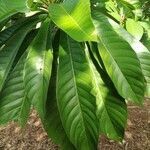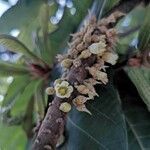Tree to 30 m. Leaves clustered toward the branch ends, the branch ends often fulvous-tomentose; petioles 1-4.5 cm long; blades oblanceolate or obovate, often acuminate, 10-40 cm long, 4-14 cm broad, glabrate or tawny-sericeous below along the midvein and primary laterals, the primary laterals 20-50 pair, the secondary laterals essentially perpendicular to and connecting the primary laterals, more prominent than the close reticulum. Flowers subsessile (pedicels to 2 mm long), clustered at defoliated nodes, each cluster often borne on a small woody cushion; sepals 8-12, spirally imbricate, + orbicular, densely appressed-sericeous externally except at the margins (there entirely glabrous), often emarginate or more deeply bilobed at the apex, 2-6 mm long, the innermost the longest; corolla ? cylindric, 6-10 mm long, the tube comprising 2/5-1/2 of the length, the lobes 4-5, oblong-obovate, appressed-sericeous except at the margins; staminodes linear-lanceolate, 2-3 mm long; staminal filaments attached at the top of the tube, 2-3.5 mm long, the anthers ca 2 mm long; ovary densely ascending-sericeous, 5-locular, the style 3.5-7 mm long, often pubescent on the basal 1/3-1/2, the stigma 5-lobed. Fruit fleshy, ellipsoid or ovoid or subglobose, mealy-roughened, 8-20 cm long, brown, the pulp yellow to red or pink, often milky; seed 1, ellipsoid, not compressed, often 5-6 cm long, lustrous brown, the elliptic or obovate scar extending the entire length, ca 2-2.5 cm broad.
More
A large tree. It grows 20-45 m tall. The trunk can be 1 m across. There can be buttresses. The branches are thick. There is a dense covering of leaves. The leaves are oval or sword shaped. They are towards the ends of the branches. They are arranged in spirals. The leaf stalk is 2-5 cm long. The leaf blade is 10-30 cm long by 4-10 cm wide. The flowers are small and almost without stalks. They grow in large numbers under branches and along leafless branches. They are in clusters of 6-15 in the axils of fallen leaves. Each flower has 5 true and 5 false stamens. The fruit is large and reddish brown. It has a rough, hard skin. The fruit can be 8-25 cm long. The flesh can be red, orange or greyish. Many varieties occur. They can be long or rounded. The amount of fibre in the flesh varies. The fruit contain one or more seeds. The seeds are large and have a sharp end. They are dark brown and smooth and shiny on one end.
A tropical plant. It is native from Mexico to Central America. It does best in the hot humid tropical lowlands. It prefers a rainfall above 1900 mm per year. They are susceptible to frost. It cannot tolerate low temperatures. Temperatures between 25°-28°C are best. They cannot tolerate drought. It grows naturally at low elevations in Central America. Trees grow from sea level to 1400 m altitude. A distinct dry season limits the fruiting season. It suits hardiness zones 10-11.




